#༺⚚༻ 𝕲𝔞𝔩𝔩𝔢𝔯𝔦𝔞 ༺⚚༻
Text
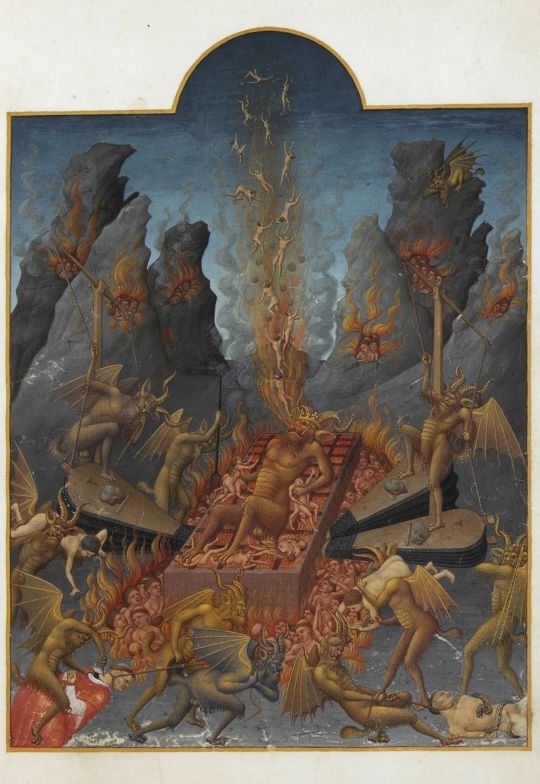
Folio 108r - Hell

This piece of Medieval Gothic art was created by the Limbourg Brothers - Herman, Paul, and Jean de Limbourg (active in France by 1399, died by 1416). It depicts Lucifer in hell, torturing the souls and being tortured himself.
The Devil is shown to be laying on top of a large grill and throwing souls of the deceased into the air with the might of his burning breath. Two demons are on the sides, blowing air under the grill to keep the flames burning. Others inflict harm on mortal souls, including that of a monk still wearing his vestments.
#༺⛧༻ 𝕮𝔞𝔫𝔢𝔰 𝖁𝔢𝔫𝔞𝔱𝔦𝔠𝔦 ༺⛧༻#༺⚚༻ 𝕲𝔞𝔩𝔩𝔢𝔯𝔦𝔞 ༺⚚༻#art#art history#medieval art#gothic art#hell#lucifer#satan#limbourg brothers
189 notes
·
View notes
Text
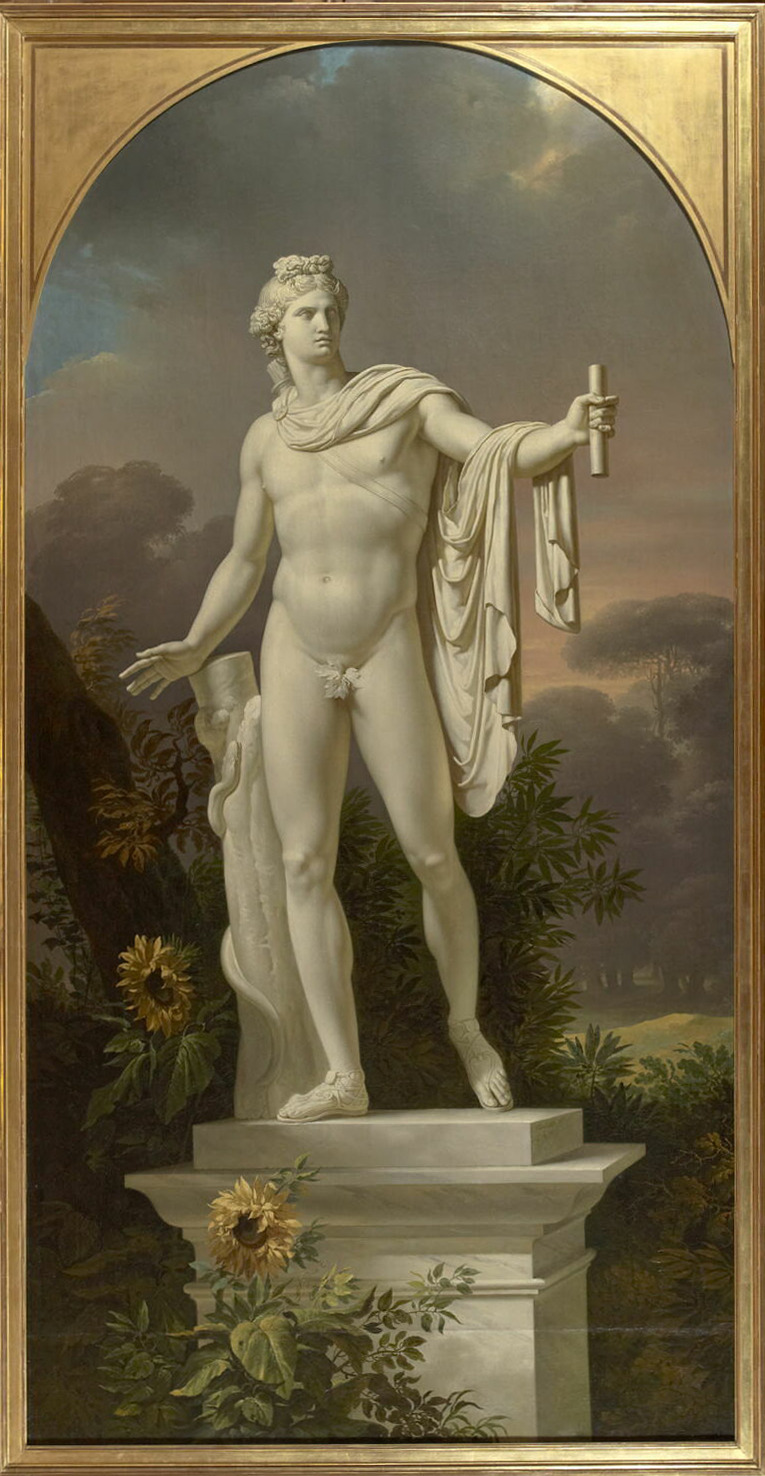
Statue d'Apollon (Apollon du Belvédère)

Painted by the French artist Charles Meynier (1768-1832) in either 1794 or 1795, this oil on canvas artwork depicts the statue of Apollo Belvedere, one of the most famous statues of the Ancient God.
It is 3 meters in height and 1.53 meters in width, towering over the viewer.
The gallery of art created by Meynier is full of other examples of paintings based off Ancient legends, myths, and stories.
#༺⛧༻ 𝕮𝔞𝔫𝔢𝔰 𝖁𝔢𝔫𝔞𝔱𝔦𝔠𝔦 ༺⛧༻#༺⚚༻ 𝕲𝔞𝔩𝔩𝔢𝔯𝔦𝔞 ༺⚚༻#art#greek gods#greek mythology#apollo#apollo belvedere#Charles Meynier#french art#french artist#tagamemnon
78 notes
·
View notes
Text

Satan as the Fallen Angel

Painted by Sir Thomas Lawrence (1769-1830) in red, white, and black chalk, this creation of phenomenal artistic mastery is a part of a larger group of art pieces. The full collection consists of six different paintings depicting scenes and characters from Milton's Paradise Lost. One is currently at the Royal Academy of Arts, one at Louvre, one in Private Collection, and two are lost.
Satan in this depiction stands in his full humanised glory - imagery typical of the late 18th century Romanticism when the fallen angel lost his beastly, animalistic appearance in art. His features here remind one more of David or Apollo Belvedere in his majestic, heavenly beauty caught right before the fall.
#༺⛧༻ 𝕮𝔞𝔫𝔢𝔰 𝖁𝔢𝔫𝔞𝔱𝔦𝔠𝔦 ༺⛧༻#༺⚚༻ 𝕲𝔞𝔩𝔩𝔢𝔯𝔦𝔞 ༺⚚༻#art#english art#english painter#english romanticism#romanticism#Sir Thomas Lawrence#18th century#satan#lucifer#paradise lost
122 notes
·
View notes
Text
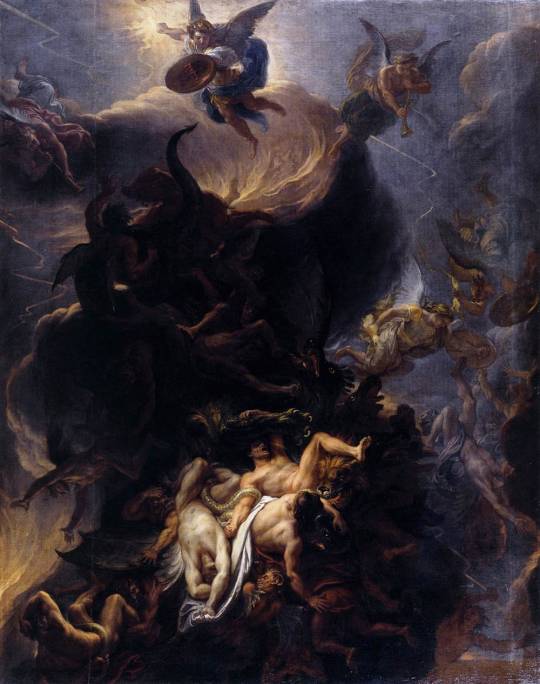
The Fall of the Rebel Angels

Created by Charles Le Brun (1619-1690), a French painter, this artpiece was designed to decorate the ceiling of the chapel within the Palace of Versaiiles, though this plan was never realized.
#༺⛧༻ 𝕮𝔞𝔫𝔢𝔰 𝖁𝔢𝔫𝔞𝔱𝔦𝔠𝔦 ༺⛧༻#༺⚚༻ 𝕲𝔞𝔩𝔩𝔢𝔯𝔦𝔞 ༺⚚༻#art#art history#history#french art#Charles Le Brun#angels#biblical#religious art#17th century
61 notes
·
View notes
Text

Catherine of Braganza in a Chariot

This ceiling painting was created in 1675 - 1684 by Antonio Verrio (1639-1707), an Italian artist. It was commissioned by Charles II and, currently, is only one of three at Windsor to survive. Most of the artist's work at the site was destroyed when George IV reconstructed the castle in the beginning of the 19th century.
The piece centers the figure of Catherine of Braganza, wife of King Charles II. She is portrayed among the clouds, drawn in a chariot pulled by swans. The Queen is accompanied by a putto carrying the Coat of Arms and a zephyr with a crown.
Verrio derived his inspiration largely from Le Brun who created mythological schemes for Louis XIV at the Palace of Versailles. For his undeniable skill in creating complex, colorful, and monumental pieces of art, Antonio Verrio was continually employed by the reigning King from 1678 until 1688. John Evelyn (1620-1706), upon seeing the construction, reported: "that excellent painter, Verrio, whose works in fresco at the King's Palace at Windsor will celebrate his name as long as those walls last".
#༺☆༻ 𝕮𝔞𝔫𝔦𝔰 𝕸𝔞𝔧𝔬𝔯 ༺☆༻#༺⚚༻ 𝕲𝔞𝔩𝔩𝔢𝔯𝔦𝔞 ༺⚚༻#art#art history#windsor castle#italian art#antonio verrio#17th century
35 notes
·
View notes
Text

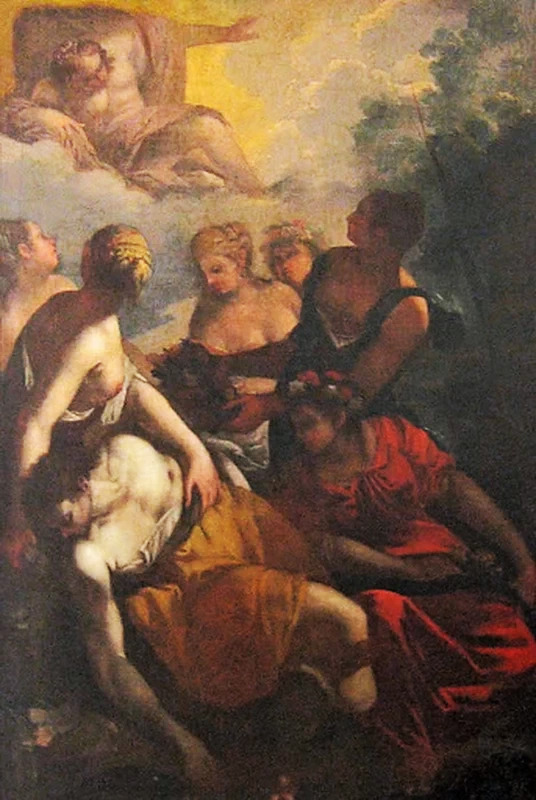
Drunk Maenad with a harpsichord and Dionysus appearing in the clouds to the Maenads

These canvases are attributed to Biagio Falcieri (Brentonico, 1628 - Verona, 1703), an Italian painter who depicted many scenes with Olympic Divinities.
Four of his pieces were donated to Fondazione Museo Miniscalchi-Erizzo by Giulio and Gianna Prosdocimo in memory of their daughter Franca: Aphrodite triumphantly advances in a riot of flowers, Feast on Olympus, Dionysus appears in the clouds to the Maenads, and Drunk Maenad with a harpsichord.
#༺☆༻ 𝕮𝔞𝔫𝔦𝔰 𝕸𝔞𝔧𝔬𝔯 ༺☆༻#༺⚚༻ 𝕲𝔞𝔩𝔩𝔢𝔯𝔦𝔞 ༺⚚༻#art#art history#17th century#Bartolomeo Guidobono#italian art#greek mythology#mythology art#maenad#dionysus#bacchus#tagamemnon
43 notes
·
View notes
Text

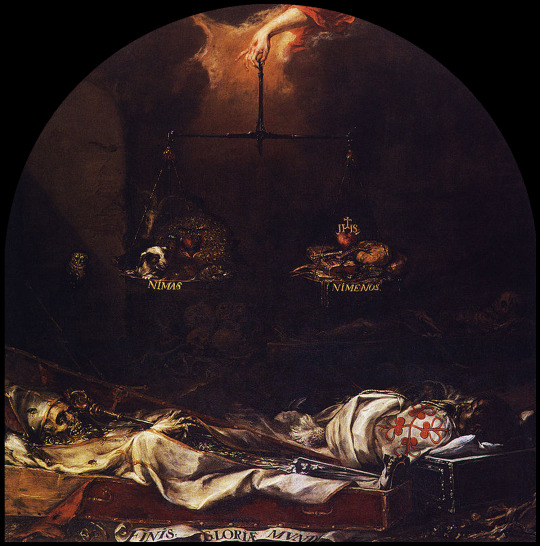
In Ictu Oculi and Finis Gloriae Mundi

These paintings are a pair of chilling, grim works commissioned for the Hospital de la Caridad and created by Juan de Valdés Leal (1622-1690), Baroque artist. The art pieces are masterful allegories of Death intended to remind the viewer of how universal Death is and how fleeting are the earthly delights.
Together, the paintings make up Las Postrimerías - the Afterlife.
In Ictu Oculi ("in a blink of an eye") shows a grim reaper exstinguishing a candle - above it the titular text that implies the quickness with which a life goes out like a flame.
Finis Gloriae Mundi ("end of worldly glory") depicts two rotting corpses, a bishop and a knight, laying in a crypt and surrounded by allegories of money and status.
#༺☆༻ 𝕮𝔞𝔫𝔦𝔰 𝕸𝔞𝔧𝔬𝔯 ༺☆༻#༺⚚༻ 𝕲𝔞𝔩𝔩𝔢𝔯𝔦𝔞 ༺⚚༻#art#art history#baroque#baroque art#juan de valdes leal#in ictu oculi#finis gloriae mundi#macabre#grim reaper#skeleton#death aesthetic#dark academia
40 notes
·
View notes
Text

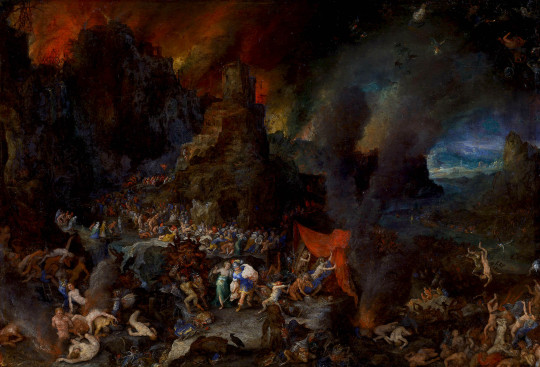
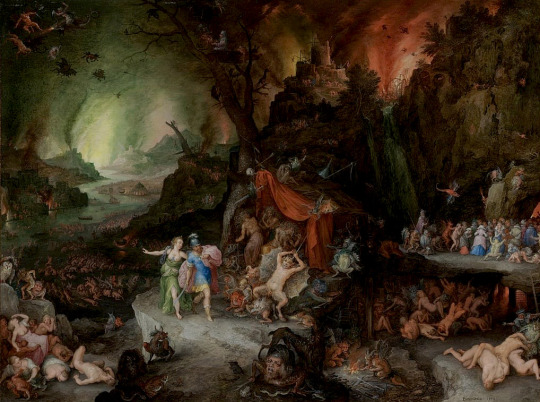
Aeneas and the Sibyl in the Underworld by Jan Brueghel the Younger (1630s)

Aeneas and the Sibyl in the Underworld by Jan Brueghel the Elder (1600s)

Aeneas and the Sibyl in the Underworld by Jan Brueghel the Elder (1600s)

#༺☆༻ 𝕮𝔞𝔫𝔦𝔰 𝕸𝔞𝔧𝔬𝔯 ༺☆༻#༺⚚༻ 𝕲𝔞𝔩𝔩𝔢𝔯𝔦𝔞 ༺⚚༻#art#tagamemnon#flemish art#17th century#Jan Brueghel the Elder#Jan Brueghel the Younger#mythology#roman mythology#aeneas#sybil
38 notes
·
View notes
Text
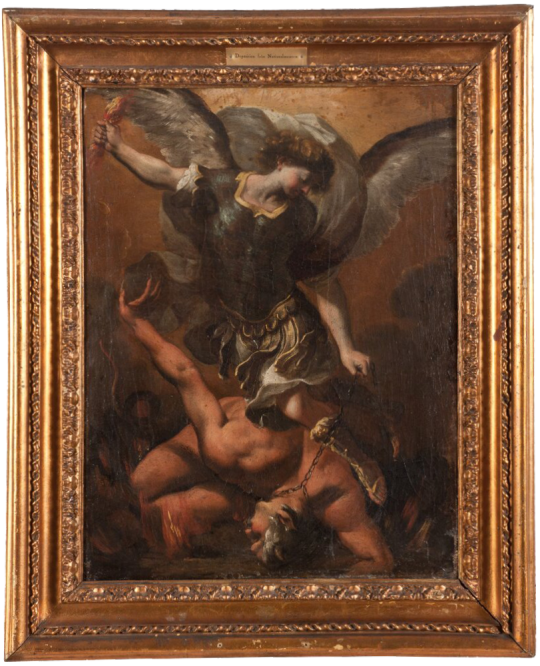
The Archangel Michael Defeating Satan

This beautiful painting is a copy likely created in the 16th-17th century after Cristofano Roncalli (1552 – 1626) also known as il Pomarancio, an Italian painter of the 16th century.
The artwork is done in oil on canvas and depicts a famous scene of archangel Michael bringing down Satan.
#༺⛧༻ 𝕮𝔞𝔫𝔢𝔰 𝖁𝔢𝔫𝔞𝔱𝔦𝔠𝔦 ༺⛧༻#༺⚚༻ 𝕲𝔞𝔩𝔩𝔢𝔯𝔦𝔞 ༺⚚༻#Cristofano Roncalli#art#art history#italian art#religious art#archangel michael#satan#16th century#17th century
19 notes
·
View notes
Text

Still Life with Rabbit and Fowls

A piece of natura morta created by famous Italian painter Gabriele Salci (Rome, first half of the 18th c.) in 1719.
#༺☆༻ 𝕮𝔞𝔫𝔦𝔰 𝕸𝔞𝔧𝔬𝔯 ༺☆༻#༺⚚༻ 𝕲𝔞𝔩𝔩𝔢𝔯𝔦𝔞 ༺⚚༻#baroque art#italian art#Gabriele Salci#18th century#eighteenth century#tw animal death
32 notes
·
View notes
Text


The Demon Flying & The Fallen Demon

These two paintings (1899, 1902) have been created by Mikhail Aleksandrovich Vrubel, one of the main artists of the Russian Symbolist tradition and a pioneer of Modernist art.
Vrubel explored the "demonic" theme in multiple paintings, starting with his Demon that depicted the main character of Mikhail Lermontov's poem by the same name. The Demon Flying and The Fallen Demon are a continuation of the same topic within his art, though now also partially inspired by Alexander Pushkin's The Prophet.
#༺⛧༻ 𝕮𝔞𝔫𝔢𝔰 𝖁𝔢𝔫𝔞𝔱𝔦𝔠𝔦 ༺⛧༻#༺⚚༻ 𝕲𝔞𝔩𝔩𝔢𝔯𝔦𝔞 ༺⚚༻#art#russian art#russian artist#19th century#symbolism#symbolist art#modernism#modernist art#Mikhail Vrubel#demons
26 notes
·
View notes
Text

L’angelo annunciante
Angel of Annunciation
Part of the Polittico Averoldi - Averoldi Polyptych (1520–1522) by Tiziano Vecellio, aka Titian, Italian Renaissance painter. The entire polyptych was commissioned by Venetian papal legate Altobello Averoldi. The angel, specifically Archangel Gabriel depicted above, is one of five, as the name suggests, paintings comprising the altar piece. The other four are: I santi Nazaro e Celso con il donatore, La Vergine annunciata, Il Cristo risorto, and Il san Sebastiano.
Archangel Gabriel is holding up a scroll that says Ave Gratia Plena, which translates to Hail full of grace - the first words uttered by Gabriel to Virgin Mary.
The polyptych is displayed at Santi Nazaro e Celso, Brescia.

#༺⛧༻ 𝕮𝔞𝔫𝔢𝔰 𝖁𝔢𝔫𝔞𝔱𝔦𝔠𝔦 ༺⛧༻#༺⚚༻ 𝕲𝔞𝔩𝔩𝔢𝔯𝔦𝔞 ༺⚚༻#renaissance art#italian art#averoldi polyptych#archangel gabriel#titian#Tiziano Vecellio
23 notes
·
View notes
Text
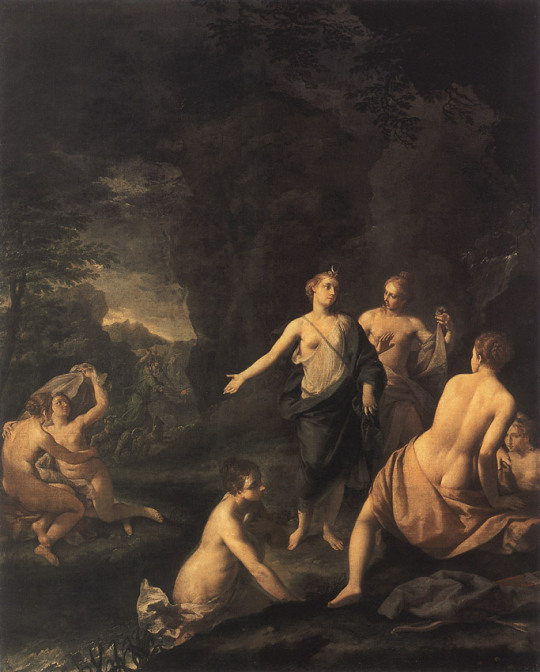
Diana and Actaeon

This painting depicts a famous mythological narrative about the hunter Actaeon bursting in when Diana and her nymphs are bathing. It was created by the renown Italian painter Ercole Graziani (1688—1765) who is remembered as a great master of Baroque art that inspired many pupils during his work in Bologna and Piacenza.
#༺⛧༻ 𝕮𝔞𝔫𝔢𝔰 𝖁𝔢𝔫𝔞𝔱𝔦𝔠𝔦 ༺⛧༻#༺⚚༻ 𝕲𝔞𝔩𝔩𝔢𝔯𝔦𝔞 ༺⚚༻#art#italian art#baroque art#Ercole Graziani#mythology#greek mythology#roman mythology#Diana#Artemis#Actaeon#tagamemnon
22 notes
·
View notes
Text

Iris in the Realm of Morpheus

This painting was created by the Italian early Baroque painter and etcher Giulio Carpioni (1613 – 29 January 1678) in 1660–1665.
#༺☆༻ 𝕮𝔞𝔫𝔦𝔰 𝕸𝔞𝔧𝔬𝔯 ༺☆༻#༺⚚༻ 𝕲𝔞𝔩𝔩𝔢𝔯𝔦𝔞 ༺⚚༻#art#baroque art#italian art#Giulio Carpioni#greek gods#Iris#Morpheus
20 notes
·
View notes
Text

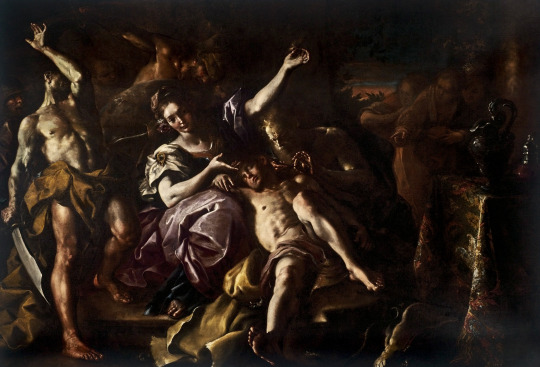
Giaele e Sisara and Sansone e Dalila by Bartolomeo Guidobono

These canvases by Bartolomeo Guidobono (Savona, 1654 - Turin, 1709) are the most recent acquisitions of the National Gallery of Liguria in Genoa. The monumental pieces depict two biblical scenes from the Old Testament. They most likely belonged to the Spinola family. After the Spinola di Pelliceria palace was donated and became the modern National Gallery of Liguria, the works were found to have been directly connected to the family's inventories and were likely commissioned by one of its members.
Guidobono was one of the most fascinating artists of the late 17th century Genoa. Until recently, there were no pieces by this painter at the National Gallery but a generous donation gifted the canvases to the museum. The pieces were published by an art historian Ezia Gavazza, specialist in seventeenth-century Genoese art.
#༺☆༻ 𝕮𝔞𝔫𝔦𝔰 𝕸𝔞𝔧𝔬𝔯 ༺☆༻#༺⚚༻ 𝕲𝔞𝔩𝔩𝔢𝔯𝔦𝔞 ༺⚚༻#art#art history#italian art#genoese art#biblical art#old testament#Bartolomeo Guidobono
12 notes
·
View notes
Text

Latone et les paysans by Gabriel Guay

This 1877 painting by Gabriel Guay (1848–1923) depicts Latona, also known as Leto, an ancient Mediterranean Goddess of pre-Hellenic origin. She is portrayed holding two children, most likely Apollo and Artemis, other Mediterranean divinities, and greeting the working peasants.
In the stories told by Antoninus Liberalis a Greek mythographer, and Ovid, a Roman writer, Latona travels to Lycia, the land oftentimes attested as her country of belonging. There, she attempts to bathe the newborn children, Apollo and Artemis, who are most known to be twins following a later tradition but in early sources aren't born at the same time. When the Goddess is denied by the local peasants, she turns them into frogs. This art follows the famous story.
#༺⛧༻ 𝕮𝔞𝔫𝔢𝔰 𝖁𝔢𝔫𝔞𝔱𝔦𝔠𝔦 ༺⛧༻#༺⚚༻ 𝕲𝔞𝔩𝔩𝔢𝔯𝔦𝔞 ༺⚚༻#art#art history#mediterranean gods#french artist#french art#latona#apollo#artemis
14 notes
·
View notes